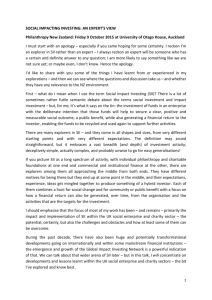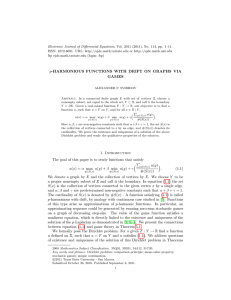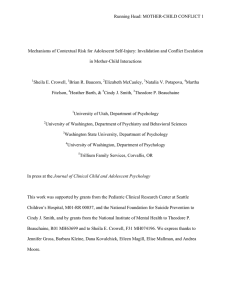SII Method for Assessment Reporting
advertisement
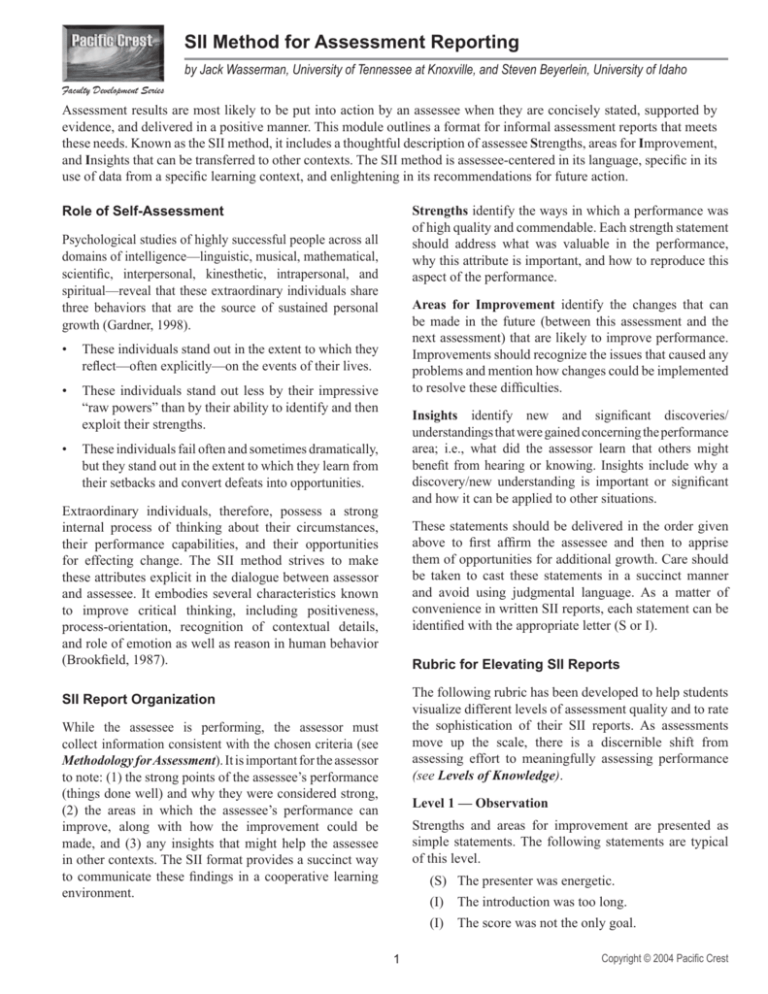
SII Method for Assessment Reporting by Jack Wasserman, University of Tennessee at Knoxville, and Steven Beyerlein, University of Idaho Faculty Development Series Assessment results are most likely to be put into action by an assessee when they are concisely stated, supported by evidence, and delivered in a positive manner. This module outlines a format for informal assessment reports that meets these needs. Known as the SII method, it includes a thoughtful description of assessee Strengths, areas for Improvement, and Insights that can be transferred to other contexts. The SII method is assessee-centered in its language, specific in its use of data from a specific learning context, and enlightening in its recommendations for future action. Role of Self-Assessment Strengths identify the ways in which a performance was of high quality and commendable. Each strength statement should address what was valuable in the performance, why this attribute is important, and how to reproduce this aspect of the performance. Psychological studies of highly successful people across all domains of intelligence—linguistic, musical, mathematical, scientific, interpersonal, kinesthetic, intrapersonal, and spiritual—reveal that these extraordinary individuals share three behaviors that are the source of sustained personal growth (Gardner, 1998). • These individuals stand out in the extent to which they reflect—often explicitly—on the events of their lives. • These individuals stand out less by their impressive “raw powers” than by their ability to identify and then exploit their strengths. • Areas for Improvement identify the changes that can be made in the future (between this assessment and the next assessment) that are likely to improve performance. Improvements should recognize the issues that caused any problems and mention how changes could be implemented to resolve these difficulties. Insights identify new and significant discoveries/ understandings that were gained concerning the performance area; i.e., what did the assessor learn that others might benefit from hearing or knowing. Insights include why a discovery/new understanding is important or significant and how it can be applied to other situations. These individuals fail often and sometimes dramatically, but they stand out in the extent to which they learn from their setbacks and convert defeats into opportunities. Extraordinary individuals, therefore, possess a strong internal process of thinking about their circumstances, their performance capabilities, and their opportunities for effecting change. The SII method strives to make these attributes explicit in the dialogue between assessor and assessee. It embodies several characteristics known to improve critical thinking, including positiveness, process-orientation, recognition of contextual details, and role of emotion as well as reason in human behavior (Brookfield, 1987). These statements should be delivered in the order given above to first affirm the assessee and then to apprise them of opportunities for additional growth. Care should be taken to cast these statements in a succinct manner and avoid using judgmental language. As a matter of convenience in written SII reports, each statement can be identified with the appropriate letter (S or I). Rubric for Elevating SII Reports The following rubric has been developed to help students visualize different levels of assessment quality and to rate the sophistication of their SII reports. As assessments move up the scale, there is a discernible shift from assessing effort to meaningfully assessing performance (see Levels of Knowledge). SII Report Organization While the assessee is performing, the assessor must collect information consistent with the chosen criteria (see Methodology for Assessment). It is important for the assessor to note: (1) the strong points of the assessee’s performance (things done well) and why they were considered strong, (2) the areas in which the assessee’s performance can improve, along with how the improvement could be made, and (3) any insights that might help the assessee in other contexts. The SII format provides a succinct way to communicate these findings in a cooperative learning environment. Level 1 — Observation Strengths and areas for improvement are presented as simple statements. The following statements are typical of this level. (S) The presenter was energetic. 1 (I) The introduction was too long. (I) The score was not the only goal. Copyright © 2004 Pacific Crest Level II — Comprehension of Key Issues Prioritize findings: Students share only the greatest strength, the greatest area for improvement, and the best insight. This encourages participants to rank the significance of their observations and to defend their thinking. Strengths and improvements are clearly stated and the reasons for the strength and suggestions for improvement are given. Insights tend to be related to the specific context of the assessment. The following statements are typical of this level. Limit response time: This is especially valuable for sharing oral assessment reports from multiple teams. Challenge participants to limit SII reports (all three parts) to less than 30 seconds. (S) The enthusiasm of the presenter inspired the audience to ask many questions. (I) Much of the material in the introduction was secondary to the purpose of the talk. (I) The team kept the problem statement in mind, not just the score. Build common understanding: Participants are asked to rephrase what they hear in other’s SII reports. This process can help clarify muddy ideas as well as emphasize important discoveries. Focus attention: The instruction directs attention to a narrow set of learning skills or performance criteria. Focusing the assessment helps to minimize motherhood and apple pie statements in favor of commentary connects with specific behaviors. Level III — Application in a Related Context This feedback builds on comprehension of key issues and gives specific ideas for improving performance in a related context. The following statements are typical of this level. Rate performance on a scale: As a reference for writing SII statements, the instructor provides several scales or rubrics for ranking performance in key areas. Assigning numerical scores can trigger recollection of supporting evidence that adds more specificity to a written SII report. (S) Taking time to practice your presentation can help you deliver your message in a confident and convincing tone. (I) The introduction should highlight a single hypothesis and explain why it is justified. (I) The team’s focus on the goal of good technical communication as opposed to just the score reminded everyone about the educational objective of the project. Collective feedback: The instructor may use the SII format at the end of a reporting session (oral or written) to comment on the entire spectrum of reports. This serves to reiterate key findings and to establish performance expectations for future reporting sessions. Level IV — Transfer to a New Context This feedback illustrates generalized understanding and is instructive in applying this understanding across a broad range of contexts. The following statements are typical of this level. Concluding Thoughts One of the driving forces for change in higher education is the need to develop students who are life-long learners so they can adapt to the ever, and rapidly, changing world around us (Brookfield, 1987). Quality self-assessment provides a solid foundation for such self-growth (Gardner, 1998). By giving and receiving SII reports, learners at any level in the curriculum gain the practice and experience they need to become quality self-assessors and self-growers. SII reports support an assessment culture where students are motivated to perform better and proactively seek to improve their own performance. (S) Researching the background of your audience can help stimulate interest and attention to your message. (I) Section divisions appear to be seamless in a carefully planned and practiced presentation. (I) Communicating your interpretation of the underlying purpose of an activity helps everyone assess whether they could have learned more from the activity. References Implementing SII Reports Brookfield, S. (1987). Developing critical thinkers: Challenging adults to explore alternative ways of thinking and acting. San Francisco: Jossey-Bass. SII reports represent a powerful formative assessment tool that can be used with a great deal of flexibility in the classroom. The following techniques have proven successful in elevating and adding variety to SII reports. Copyright © 2004 Pacific Crest Gardner, H. (1998). Extraordinary minds. New York: Basic Books. 2 Pacific Crest www.pcrest.com (630) 737-1067
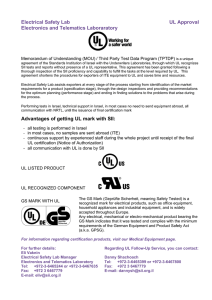
![[SII] Observations and what they tell us](http://s2.studylib.net/store/data/005777176_1-4007393d604d028757bc9097e7c6881d-300x300.png)
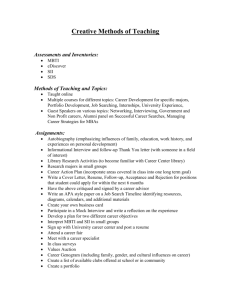


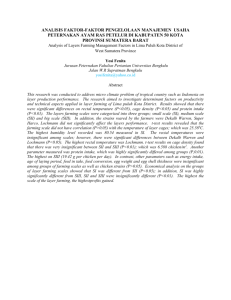
![∫ Lecture 19 [ ] (](http://s2.studylib.net/store/data/013477666_1-57eb1304c9e4a210504ef2a0e5fa5490-300x300.png)


